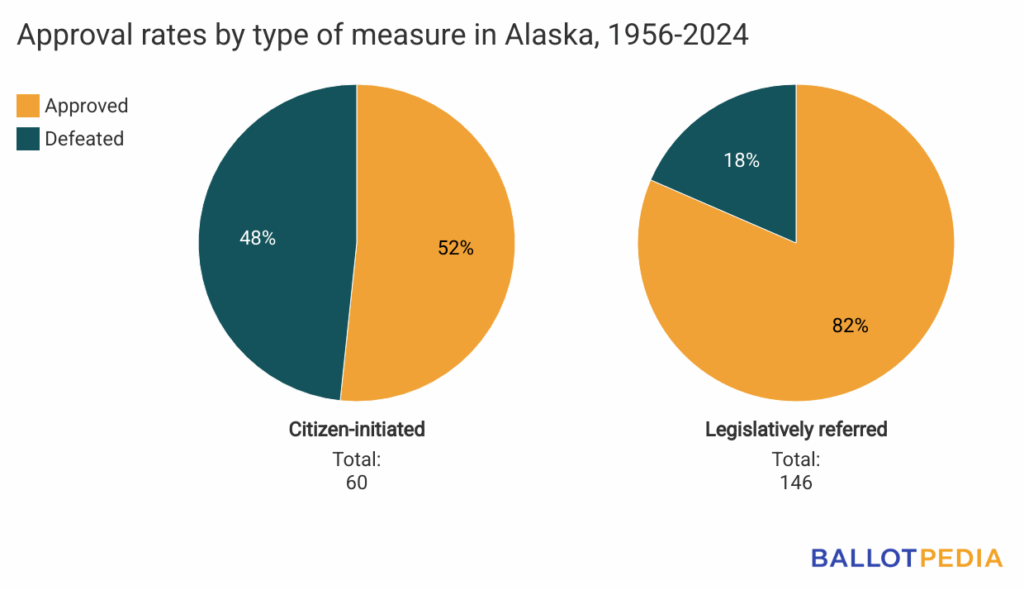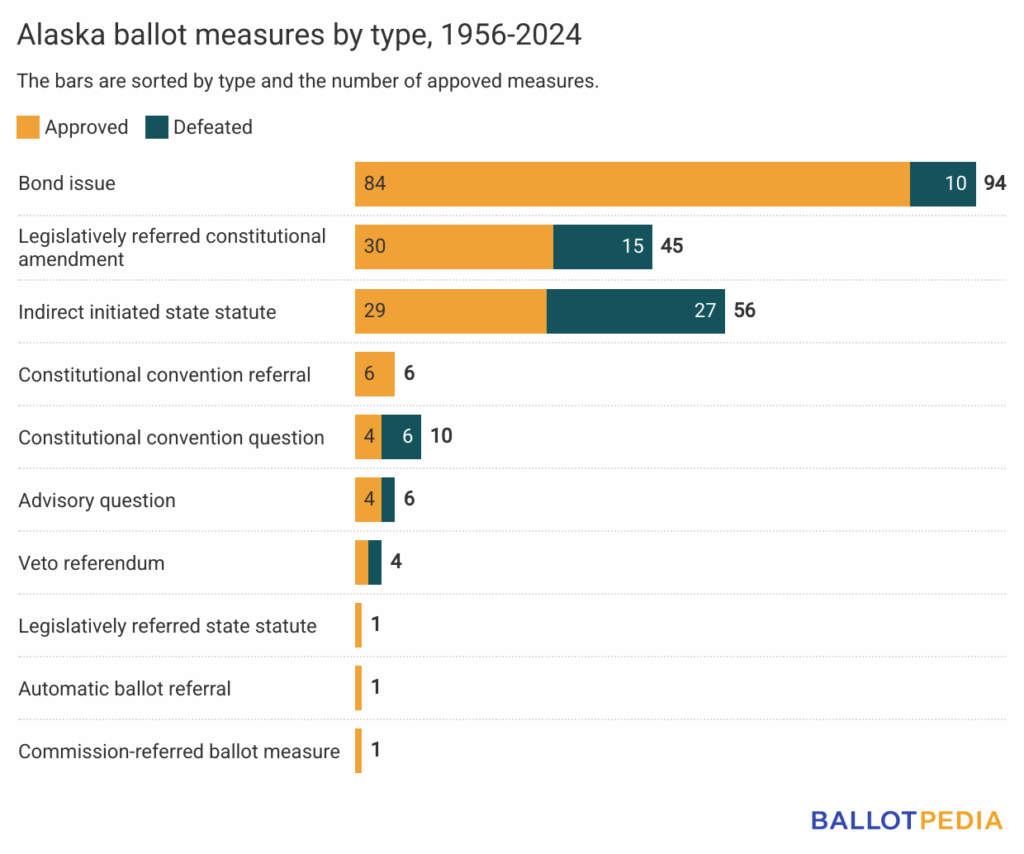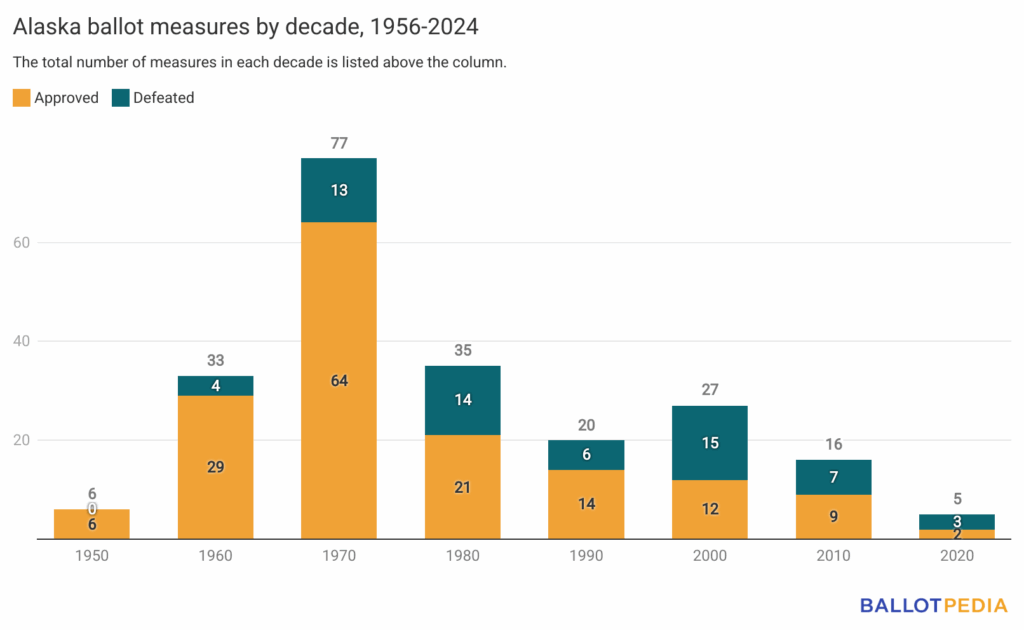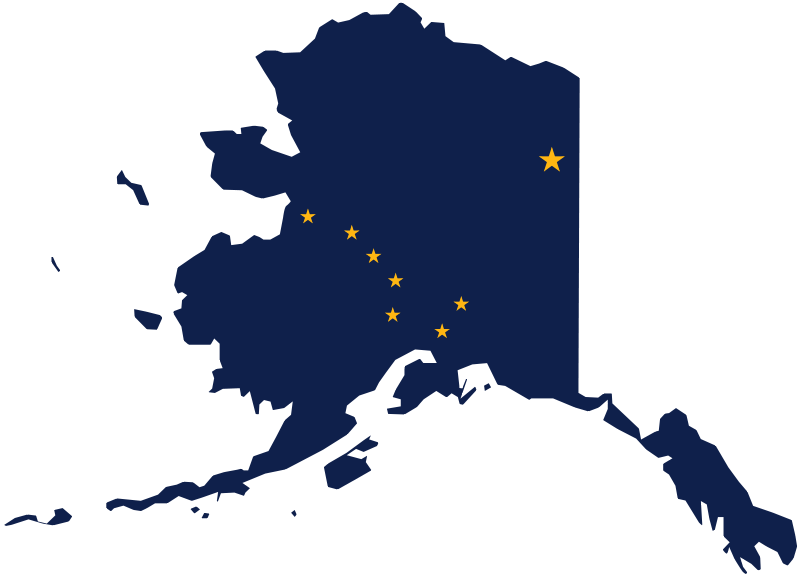Ballotpedia has completed an inventory of all Alaska ballot measures since 1956—the year voters ratified the state constitution and three years before Alaska gained statehood. Since 1956, voters have decided 220 ballot measures. Of those, 158 (72%) were approved and 62 (28%) were defeated.
In Alaska, most measures are placed on the ballot either through the citizen initiative process or by the state legislature. Citizens can place indirect initiated state statutes on the ballot, which amend state law, or veto referendums, which uphold or repeal existing laws. Out of all the statewide ballot measures in Alaska, citizen initiatives made up 27% of the total measures on Alaska ballots. Fifty-one percent of these measures were approved by voters.
The state legislature can refer constitutional amendments, bond measures, and advisory questions to the ballot. Out of the 146 referrals to the ballot, 82% were approved by voters.
Additionally, seven measures were automatic constitutional convention questions, six originated from the state’s constitutional convention, and one was placed on the ballot by a state commission.

There are nine different types of ballot measures in Alaska. Bond issues, which are referred to the ballot by the legislature, appeared most frequently, with voters deciding on 94 of them in the state’s history, approving 84 and rejecting 10. There were six constitutional convention referrals, all of which were decided by voters before Alaska reached statehood. All of these measures were approved. Constitutional convention questions, which are automatically placed on the ballot, had the lowest approval, with six questions rejected and one of them approved.

Alaska ballot measures addressed 100 unique topics. The most common topic was bond issues, which included 94 measures. Other common topics included higher education funding (14), public education funding (14), highways and bridges (12), ports and harbors (12), airport infrastructure (11), and the state capital (nine).
Below is a selection of notable and unique ballot measures in Alaska’s history. For a more detailed list, see here.
- On April 24, 1958, voters approved the Tennessee Plan, which required the election of congressional representatives regardless of federal statehood approval. Voters also ratified a state constitution at this election.
- Congress passed statehood legislation requiring voter approval of three questions, which President Dwight Eisenhower (R) signed on July 7, 1958. On August 26, 1958, voters approved the three questions: Proposition 1, which asked whether Alaska should be admitted as a state; Proposition 2, which sought approval for the state's boundaries; and Proposition 3, which approved the Alaska Statehood Act. Alaska became a state on January 3, 1959.
- Alaskans decided 12 ballot measures related to fishing or hunting regulations. Examples include:
- Proposition 3 (1956), which was approved before statehood to prohibit the use of fish traps for commercial salmon fishing in coastal waters.
- Ballot Measure 7 (1982), which would have prohibited the state from classifying persons based on race, sex, economic status, land ownership, past use, dependence on resources, or other specified criteria in matters related to hunting, fishing, and trapping. Voters rejected Ballot Measure 7.
- Ballot Measure 3 (1996), Ballot Measure 6 (2000), Ballot Measure 2 (2008) addressed airborne or land-and-shoot hunting for wolves or bears.
- Alaskans voted on nine ballot measures related to the state capital. Votes approved moving the state capital in 1974 and 1976, but a funding measure later failed, and the capital remained in Juneau.
- In 1976, voters approved Proposition 2, which created the Alaska Permanent Fund. The constitutional amendment required that 25% of the state's mineral revenues, including oil lease rentals, royalties, federal mineral revenue-sharing payments, and bonuses, be deposited into the fund. The fund’s principal would be invested to generate income, while the earnings would be deposited into the state’s general fund. In 1980, the state enacted a law to create the Permanent Fund Dividend (PFD).
- In 1980, voters approved the Establish Statehood Commission Measure. The ballot measure created the 11-member Alaska Statehood Commission to examine and recommend possible changes to the state's relationship with the United States.
- Alaskans approved several other ballot measures related to the state's relationship with the federal government, including Ballot Measure 5 (1982), which claimed state ownership of federal land in Alaska, with exceptions; Ballot Measure 1 (1988), which provided that the state can give preference to state residents over non-residents; and Ballot Measure 1 (1996), which required that any changes to the Alaska Statehood Act proposed by Congress be approved either by a majority vote of Alaskan voters or by a two-thirds vote of the state legislature.
Of the 220 measures on the ballot in Alaska, five were decided by less than a percentage point.
The measure with the closest margin was the latest measure on the ballot in 2024, Measure 2, which would have eliminated top-four primaries and ranked-choice voting general elections in Alaska, replacing that with a party primary system. The measure was defeated, with 49.88% of voters approving it and 50.12% defeating it, with a margin of 0.23 percentage points. Four years earlier, voters approved a ballot initiative to establish top-four RCV.
The measure with the widest margin was in 1994, when voters approved the Crime Victims’ Rights Amendment, which allowed victims of crimes to receive information about the case and take part in proceedings involving accused offenders. The amendment was approved by 86.61% of voters and rejected by 13.39%, resulting in a margin of 73.23 percentage points.
The average number of measures per decade was 28. The six measures in the 1950s were all decided by voters prior to statehood in 1959, and had the highest approval rating with 100% approval. The decade with the lowest approval rating is the 2020s, where, thus far, three measures (60%) were defeated and two (40%) were approved. The 1970s had the highest number of ballot measures, with 77 total measures on the ballot.

The inventory of Alaska statewide ballot measures is part of Ballotpedia's Historical Ballot Measure Factbook, which will document nearly 200 years of direct democracy in the United States. This ongoing research effort will provide an unparalleled resource for researchers, reporters, and the voting public on how ballot measures have evolved, the issues they've covered, and the role they have played in our civic life.


